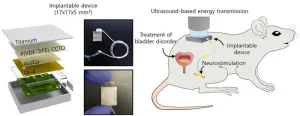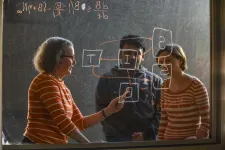An electrophysiological breakthrough for diabetic brain studies
Delicate brain and gentle electrode
2024-01-04
(Press-News.org)
Overview
A research team from the Institute for Research on Next-generation Semiconductor and Sensing Science (IRES²) at the Toyohashi University of Technology, National Institute of Technology, Ibaraki College, and TechnoPro R&D Company has successfully demonstrated low-invasive neural recording technology for the brain tissue of diabetic mice. This was achieved using a small needle-electrode with a diameter of 4 µm. Recording neuronal activity within the diabetic brain tissue is particularly challenging due to various complications, including the development of cerebrovascular disease. Because of the significant advantage of the miniaturized needle-electrode compared to conventional technologies, the needle electrode minimized tissue injury and enabled stable recording for an entire month.
Details
Diabetes is known to cause various complications, including the development of cerebrovascular disease, which is closely linked to Alzheimer’s disease due to its contribution to neuronal reduction. In the study of brain diseases, quantitative analysis through recording of neuronal activities with microelectrode holds great potential. However, recording from diabetic brains is expected to be more challenging than normal brains due to the complications associated with electrode penetration. The research team has successfully addressed this challenge by developing a low-invasive recording technology.
“Our challenge was to develop a technique to record neuronal activities from a mouse model of diabetes. We achieved this goal by demonstrating a neural recording technique using a microelectrode with a tip diameter of 4 µm. Our technique successfully recorded neuronal activity in diabetic mice while minimizing tissue responses. These findings suggest that our electrode can be applied to various damaged brain tissues, not only diabetes but also other diseases,” explains the first authors of the article, master student Rioki Sanda and Ph.D. Koji Yamashita.
Development Background
Professor Takeshi Kawano, leader of the research team, explains the motivation behind their project: “Diabetes is a complex disease known to cause various complications, particularly vascular disorders. These disorders can lead to gangrene in the limbs, ultimately necessitating amputation. Brain-machine interface (BMI) technology holds immense promise in assisting patients who have lost limbs, enabling them to control artificial limbs through brain signals. However, the penetration of conventional electrodes into diabetic brain tissues induces damage, making the application of BMI technology in these patients considerably riskier than others. Recognizing this crucial need, we launched a project to develop a low-invasive recording technique specifically for patients suffering from diabetes-related vascular disorders.”
Future Outlook
The research team is confident that their recording technology, demonstrated successfully in diabetic mice, holds significant potential for broader applications. They envision its use in drug discovery studies using diverse model mice with various diseases. Furthermore, the team aims to expand the technology’s reach to other animal models, including rats and monkeys, to accelerate the development of next-generation BMIs with greater efficacy and wider applicability.
Reference
Rioki Sanda, Koji Yamashita, Hirohito Sawahata, Kensei Sakamoto, Shota Yamagiwa, Shohei Yokoyama, Rika Numano, Kowa Koida and Takeshi Kawano (2023). Low-invasive neural recording in mouse models with diabetes via an ultrasmall needle-electrode, Biosensors and Bioelectronics, https://doi.org/10.1016/j.bios.2023.115605.
Acknowledgements
This work was supported by JSPS KAKENHI (Grant Numbers 17H03250, 26709024, and 20H00244) and Strategic Advancement of Multi-Purpose Ultra-Human Robot and Artificial Intelligence Technologies program from NEDO, Adaptable and Seamless Technology transfer Program through Target-driven R&D (A-STEP) from JST, and Nagai Foundation for Science & Technology. R. N. was supported by the Takeda Science Foundation. K. K. was supported by JSPS KAKENHI (Grant Number 15H05917, 20H00614).
END
[Attachments] See images for this press release:

ELSE PRESS RELEASES FROM THIS DATE:
2024-01-04
Medical technology innovations achieved by integrating science and medicine have improved the quality of life for patients. Especially noteworthy is the emergence of electronic devices implanted in the body, such as in the heart or brain, which enable real-time measurement and regulation of physiological signals, presenting new solutions for challenging conditions like Parkinson's disease. However, technical constraints have hindered the semi-permanent use of electronic devices after their implantation.
A collaborative research team led by Professor Sung-Min Park from the Departments of Convergence IT Engineering, Mechanical Engineering, and ...
2024-01-04
LOS ANGELES — Hearing loss affects approximately 40 million American adults, yet only one in 10 people who need hearing aids use them, research shows.
Those who don’t use hearing aids but should may want to make wearing them one of their New Year’s resolutions, according to a new study from Keck Medicine of USC published today in The Lancet Healthy Longevity.
“We found that adults with hearing loss who regularly used hearing aids had a 24% lower risk of mortality than those who never wore them,” ...
2024-01-04
Australian researchers have successfully trialled a novel experiment to address offensive and rude comments in operating theatres by placing ‘eye’ signage in surgical rooms.
The eye images, attached to the walls of an Adelaide orthopaedic hospital’s operating theatre without any explanation, had the desired effect in markedly reducing poor behaviour among surgical teams.
Lead researcher University of South Australia Professor Cheri Ostroff attributed the result to a perception of being “watched”, even though the eyes were not real.
The three-month experiment ...
2024-01-04
The avocado has soared to unprecedented heights of popularity, gracing the plates of toast enthusiasts and health-conscious individuals worldwide. But what are the overlooked consequences of our latest food obsession?
“The avocado has come to represent so much more than just a fruit. It’s wrapped up with ideas of generational conflict, environmental chaos and social injustice. Over the last century, through careful marketing, it has evolved into a commodity crop with a huge social media following.” says Honor May Eldridge, a food policy expert who works to promote sustainable agriculture around the ...
2024-01-03
CLEVELAND, Ohio – Jonathan Stamler, MD, has been named a Fellow of the National Academy of Inventors (NAI). Dr. Stamler is the co-founder and president of Harrington Discovery Institute at University Hospitals (UH), and the Robert S. and Sylvia K. Reitman Family Foundation Distinguished Professor of Cardiovascular Innovation at the Case Western Reserve University School of Medicine.
Election as an Academy Fellow is the highest professional distinction awarded solely to inventors and the 2023 Class of Fellows ...
2024-01-03
Suzanne Lenhart, Chancellor’s Professor in the Department of Mathematics, will join a storied list of honored speakers to deliver the Josiah Willard Gibbs Lecture at the world’s largest annual math gathering, the American Mathematics Society (AMS) Joint Mathematics Meetings (JMM2024), taking place January 3–6, 2024, in San Francisco.
JMM2024 brings researchers from 20 national and international partner associations to share the latest developments in mathematical thought and application.
Lenhart is the ...
2024-01-03
BIRMINGHAM, Ala. – The blood-brain barrier blocks the entry of antibodies into the brain. This limits the potential use of antibody therapeutics to treat brain diseases, such as brain tumors.
Elsewhere in the body, more than 100 United States Food and Drug Administration-approved therapeutic antibodies are used by medical teams to treat cancers and autoimmune, infectious and metabolic diseases. Finding ways to transport therapeutic antibodies across the blood-brain barrier — from the peripheral blood stream into the central nervous system — could create effective treatments that act in the brain.
In a study published in the journal Frontiers in Cell and Developmental ...
2024-01-03
Today, the U.S. Department of Energy (DOE) announced the issuance of a Request for Proposals (RFPs) for the competitive selection of a management and operating contractor for Fermi National Accelerator Laboratory (FNAL).
FNAL is a single-purpose laboratory that leads the nation in the construction and operation of world-leading accelerator and detector facilities and in the development of the underlying technology for particle physics research. Its mission is centered on delivering breakthrough science and technology ...
2024-01-03
For nearly 20 years, Stephen Ball has been a man on a mission: helping older Missourians stay healthy and get stronger through physical activity.
In 2005, the professor in the University of Missouri College of Health Sciences helped created a program called Stay Strong Stay Healthy (SSSH). Since then, the eight-week strength training program has helped more than 20,000 older adults across five states. Participants aged 60 and up are taught how to safely complete exercises — including squats, bicep curls and lunges — in a comfortable, friendly environment.
“One thing I always ...
2024-01-03
Researchers from Rutgers and other institutions have uncovered significant variations in how inflammatory bowel disease (IBD) affects people of different races, sexes and places of birth.
The study, published in Gastro Hep Advances, may assist caregivers and help shed light on how diet, lifestyle and genetics can affect the development and disease course of IBD, a term for two conditions – Crohn’s disease and ulcerative colitis – that cause chronic inflammation in the gastrointestinal tract.
“IBD has historically been a disease of Caucasian populations in Europe and North America, but now we’re seeing it among all races and in people all over the ...
LAST 30 PRESS RELEASES:
[Press-News.org] An electrophysiological breakthrough for diabetic brain studies
Delicate brain and gentle electrode







